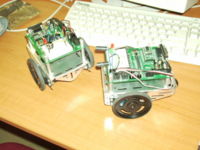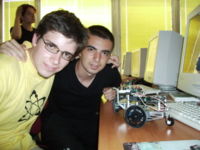Difference between revisions of "LoveBots"
| Line 20: | Line 20: | ||
1. The first robot sends a 38.5kHz signal to both of its infrared LEDs, and in the same time performs a random movement around the room. | 1. The first robot sends a 38.5kHz signal to both of its infrared LEDs, and in the same time performs a random movement around the room. | ||
| + | |||
2. The second robot looks out for the infrared signal sent from the first robot - it can be detected by the left, the right, or by both of its sensors. Then, based on a few IF-THEN statements, the robot decides how to move in order to "catch" the first robot. | 2. The second robot looks out for the infrared signal sent from the first robot - it can be detected by the left, the right, or by both of its sensors. Then, based on a few IF-THEN statements, the robot decides how to move in order to "catch" the first robot. | ||
Revision as of 13:51, 15 July 2008
Project: LoveBots
Overview
Author(s): Andrey Hinkov, Ekin Guvencoglu
Country(s): Bulgaria/Turkey
Date: 11.07.2008
Activity: Robolution 2008, Bratislava
Abstract
Project Description: The LoveBots are two mobile robots - a "boy" and a "girl". They are in love and follow each other wherever they go.
Hardware Design: The project is based on two Boe-Bot educational platforms. One of the robots is equipped with 2 infrared emitting LEDs, and the other - with two infrared sensors.
Software Design: The LoveBots are programmed via the BASIC programming language. Unfortunately the original source code was lost, but the idea behind the project is simple:
1. The first robot sends a 38.5kHz signal to both of its infrared LEDs, and in the same time performs a random movement around the room.
2. The second robot looks out for the infrared signal sent from the first robot - it can be detected by the left, the right, or by both of its sensors. Then, based on a few IF-THEN statements, the robot decides how to move in order to "catch" the first robot.

